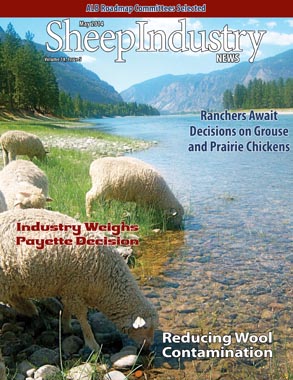
- May 2014
- President’s Notes
- Market Report
- Industry Weighs Payette Decision
- Producers Now Eligible for USDA Disaster Assistance
- ESA listing of Sage Grouse
- Parentage Test Could Benefit Sheep Producers
- Sheep Begin Fire Break Duties
- Don’t Let Your Farm be Fodder for Activists
- Reducing Contamination Vital to Wool Quality
- Data-Driven Approach
- ASI Awarded MAP, FMD Funding
- Obituaries
- Business Spotlight
- ASI News Briefs
- ALB Roadmap Committees Selected
Data Driven Approach
Producers Have Tools Available to Help Make Genetic Selections
Terri Queck-MATZIE
Sheep Industry News Contributor
Sheep in the show ring are fun, and a good way to get kids involved and teach them to care for livestock, but it doesn’t shed any light on genetic value, says Mark Van Roekel, a sheep producer from northwest Iowa.
Van Roekel no longer relies on mere visual appraisal when selecting genetics to improve his herd. He favors a data-based approach. Van Roekel participates in the National Sheep Improvement Program (NSIP).
NSIP collects multi-generational performance and carcass data to generate Expected Breeding Values (EBV), a calculated prediction of progeny potential. Numerous heritable traits are measured and tracked – from carcass and reproductive traits, to parasite resistance, to wool production – allowing producers to make genetic selections based on enhancing or deleting traits of interest.
For instance, Loin Muscle Depth is measured by ultrasound and adjusted to a standard post-weaning weight. Animals with a positive Loin Muscle Depth EBV are expected to produce offspring with larger loin eyes. Likewise, those with a negative Fat Depth EBV are expected to produce leaner progeny.
“The numbers tell you 90 percent of what you need to know,” says Van Roekel, who now chooses and buys his breeding stock based on performance data. He likes a terminal ram with a high post-weaning weight (PWWT) of at least 5, and a positive Loin Muscle Depth score.
Van Roekel’s livestock background makes him a natural for the data approach. Born and raised a swine producer, he switched to sheep when it became no longer cost-effective to maintain the needed facilities.
Starting with a small flock, he soon saw the need to increase numbers by holding back ewe lambs for breeding. But he didn’t want to just increase the size of his flock; he wanted to improve quality as well.
That’s when he turned to NSIP rams for breeding.
“The EBDs generated by NSIP provide information on current and lifetime production – for multiple generations and related stock,” says Van Roekel. “It’s invaluable information. You can’t look at a ram and assess its maternal or muscling qualities.” And those qualities are essential for producing future breeding stock.
Van Roekel now breeds the top one-third of his ewes (based on pounds of lamb weaned in past years) to NSIP Polypay rams, and the remainder to terminal rams with an emphasis on growth.
His chosen rams rank in the top 10 percent of the breed, according to NSIP EBVs. His terminal rams are purchased based on the NSIP Carcass-Plus index.
“So far, the U.S. sheep industry is focused on growth, on total pounds, not muscle. But someday it will be important, so we might as well get started.” Van Roekel sells on contract, but contracts that pay for muscle are rare, a facet of the industry he anticipates will change with time.
“If we breed based on just growth rate, we’re not helping develop muscle,” he continued. “And muscling will continue to gain importance as the consumer demands a certain quality of meat.”
Van Roekel cited recent surveys that show Millennial consumers have a desire to stretch their wings and try new culinary experiences, and that includes lamb. “They enjoy cooking and want their food to taste and look good. If it’s not good quality, they won’t try it again.”
He adds the sheep industry currently does a good job of filling niche markets, producing lambs at specified age and size. Now, as muscle quality gains importance along side total pounds of meat, the use of data becomes increasingly important.
Data-based breeding decisions are one way the lamb meat industry is utilizing technology. Managing data is another. Van Roekel tracks his flock with electronic ID tags, simplifying data organization and animal handling. “It’s tremendously time saving.” A touch screen enters all data, like birth weights and wean weights. “You punch in the weight, and it joins all the other data on that animal – at the touch of a fingertip. You can access a lot of data in less than a minute with the animal’s history in a hand-held unit.”
The use of data and modern recordkeepiong methods are especially attractive to young producers entering the lamb business. Sheep are growing in popularity with new producer as they find ewes and facilities to be a relatively inexpensive investment and a good complement to other types of livestock and crop production.
“They’re fun, and spread out the worload,” says Van Roekel. “And NSIP is a huge step forward for an industry with a bright future and plenty of room to grow.”
More information on NSIP can be found at www.nsip.org

